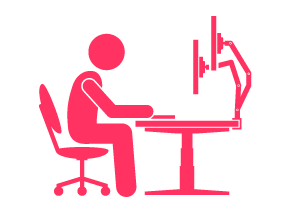Accommodations
The Basics
What are workplace accommodations?
Workplace accommodations can mean small adjustments like setting up the employee’s desk and chair so it’s ergonomically correct (e.g., chair seat and armrest height, monitor height, etc.), or moving the employee’s parking spot closer to the entrance. They can also include more significant accommodations such as changes to duties, job modifications, or alternate positions or FTEs.
These changes can be formal or informal, and temporary or permanent.
Workplace accommodations refer to a range of changes that can make a positive difference for employees with arthritis, joint pain, back pain, and other types of health conditions

Why are workplace accommodations important?
Workplace accommodations are important because they:
- Help keep employees healthy and productive at work
- Eliminate the cost of having to find and train a qualified employee
- Benefit all employees, not only those who ask for them
- Many are cost-effective
- Help build loyalty and job satisfaction
As an employer, you are required to reasonably accommodate your employees. Legally, employers have a duty to accommodate. You also need to be aware of and respect your employees’ rights to privacy.
Did You Know?
Canadian employers may qualify for funding to cover the cost of technological devices and other accommodations.
Where to Start
You can do many things to support employees without requiring a formal request for an accommodation. For example, providing flexibility and autonomy gives employees more opportunities to make changes without having to ask for a formal accommodation. For an employee with a chronic condition like arthritis, this may mean taking five 3-minute micro breaks instead of one 15-minute break to help with stiffness and fatigue. It could also mean employees adjust their order of tasks to prevent overuse of a painful joint.
The next sections will provide more detailed information on workplace accommodations:
